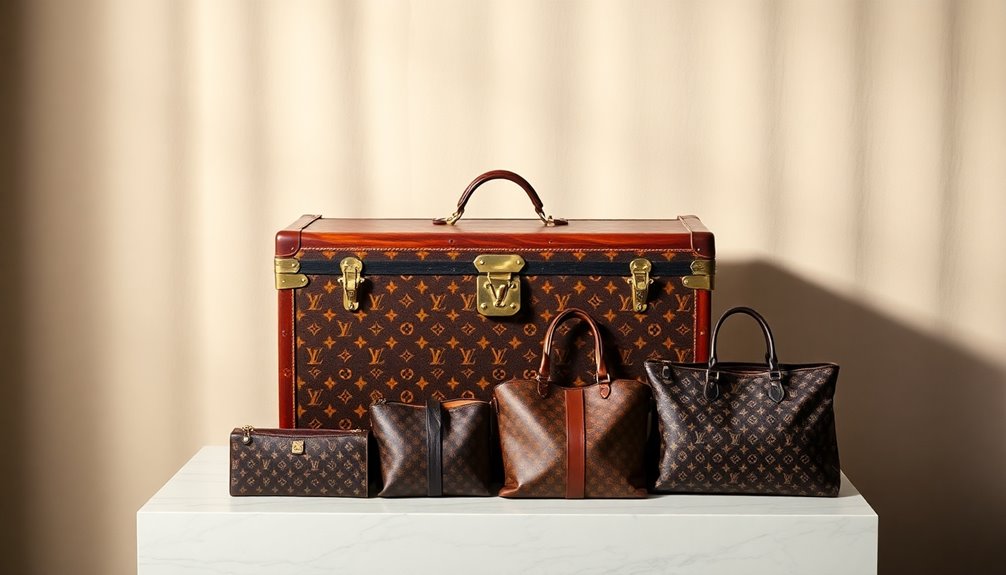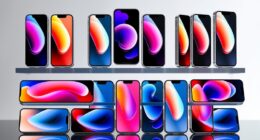Luxury fashion weeks around the world include key events in New York, Paris, Milan, and London, each known for distinct styles and signature shows. Emerging markets like Seoul, Dubai, and Lagos are also gaining prominence with innovative formats and regional influences. These events now blend physical and digital experiences, shaping trends, sustainability efforts, and industry standards globally. To discover how these weeks influence high-end fashion and what’s next, keep exploring the latest trends and innovations.
Key Takeaways
- The most prominent luxury fashion weeks are held in Paris, Milan, New York, and London, showcasing haute couture and high-end designs.
- Paris Fashion Week is renowned for haute couture and sets global industry standards with iconic brands like Chanel and Dior.
- Milan focuses on Italian luxury brands such as Gucci, Prada, and Valentino, emphasizing craftsmanship and elegant tailoring.
- New York Fashion Week highlights American designers and innovation, blending luxury with contemporary trends.
- Many cities like Seoul, Dubai, and Lagos now host luxury-focused fashion events, blending regional influences with global luxury standards.
Major Fashion Capitals and Their Signature Events

The four major fashion capitals—New York, London, Milan, and Paris—stand out as the most influential centers for luxury fashion weeks. These Big Four fashion weeks happen twice a year, showcasing the latest in haute couture and ready-to-wear collections. In New York, held in February and September, you’ll see a focus on innovation, streetwear, and American designers like Marc Jacobs and Michael Kors. Milan Fashion Week emphasizes Italian craftsmanship, luxury brands like Gucci and Prada, and elegant tailoring in February/March and September/October. Paris, the season’s grand finale, highlights haute couture from brands like Chanel and Dior during late February/March and September/October. London sets itself apart with experimental designs, showcasing emerging British talent during the same periods. Additionally, the integration of digital technologies is transforming how designers present their collections and engage with a global audience, making the fashion weeks more accessible and innovative. Moreover, the use of trend analysis tools is becoming more prevalent in predicting upcoming styles and consumer preferences, further enhancing the industry’s forward-looking approach. The adoption of sustainable practices is also gaining traction among designers, reflecting a growing emphasis on environmental responsibility within the industry.
The Evolution of Global Fashion Week Formats

You’ll notice that many fashion weeks now blend digital and physical elements, making shows more accessible than ever. Hybrid formats have become common, allowing brands to reach global audiences through live streams and virtual experiences. Different regions are customizing these formats to suit their unique cultures and industry needs, transforming how fashion events are held worldwide. Additionally, some fashion weeks incorporate Mazda Tuning elements to optimize their presentation setups, ensuring the best possible experience for both attendees and viewers. The integration of innovative event technology solutions, such as augmented reality and 3D modeling, further enhances the immersive experience for virtual audiences. Recognizing the importance of asset division planning, organizers are increasingly adopting strategies to streamline event management and resource allocation. This shift towards digital engagement also helps cater to a broader, more diverse global audience, expanding the reach and impact of fashion weeks worldwide.
Shift to Digital Platforms
As luxury fashion weeks embrace digital platforms, brands are transforming how they showcase collections by blending physical runway shows with virtual presentations. This shift allows you to experience fashion weeks from anywhere through virtual showcases and live streams. You’ll notice a few key changes:
- The use of augmented reality and 3D digital presentations enhances online engagement and interactivity. These innovative technologies provide a more immersive visual experience that appeals to modern audiences.
- Fashion brands leverage social media and dedicated apps to deliver real-time updates, behind-the-scenes content, and virtual front-row experiences.
- The move to digital platforms helps brands shorten lead times, speed up collection releases, and gather faster consumer feedback. This transition also introduces new digital marketing strategies that broaden a brand’s reach.
- Additionally, understanding emotional support can help industry professionals manage stress and adapt to these rapid changes more effectively. This evolution also benefits retail hours, enabling brands and consumers to connect beyond traditional store timings and schedules.
This progression makes fashion weeks more accessible and efficient, expanding reach beyond traditional in-person audiences while keeping the excitement alive through innovative virtual showcases.
Hybrid Show Formats Emerge
With travel restrictions and global audiences in mind, many luxury fashion weeks now adopt hybrid formats that combine in-person runway shows with digital presentations. This shift allows designers to showcase collections live to select audiences while streaming to viewers worldwide. Hybrid models increase accessibility, boost media coverage, and enhance engagement. Virtual showrooms and augmented reality experiences have become essential, enabling buyers and media to interact remotely with collections. Data shows online viewership can rise by up to 60%, reflecting the success of these formats. This evolution highlights the industry’s move toward flexible, tech-driven events that serve both physical attendees and global digital audiences.
| Format Element | Purpose | Benefit |
|---|---|---|
| In-person runway | Live showcase | Exclusive experience |
| Digital presentations | Broader reach | Increased accessibility |
| Virtual showrooms | Remote engagement | Interactive collection access |
Regional Event Variations
Regional fashion weeks are adapting their formats to reflect local cultural, economic, and technological contexts, shaping how collections are presented and experienced. You’ll notice many regional events, like Seoul and Mumbai, adopting hybrid models that combine physical runway shows with digital streaming to reach global audiences. This approach broadens access and engages viewers worldwide. Some regions, such as Arab and Berlin Fashion Weeks, focus on sustainable, innovative presentations aligned with regional industry priorities. Others, like Latin America and Southeast Asia, emphasize promoting local talent through dedicated platforms, diverging from traditional runway formats. Additionally, the integration of organic techniques into event planning and presentation processes highlights the evolving sustainability focus within the industry. These regional event variations demonstrate a shift toward more inclusive, digital, and environmentally conscious fashion weeks, tailoring experiences to cultural nuances and technological advancements while expanding the reach of regional fashion. Furthermore, many of these events are incorporating digital innovations to enhance audience engagement and showcase regional creativity in new ways. This ongoing evolution reflects a broader cultural intelligence that enables organizers to adapt effectively to diverse cultural expectations and preferences. Recognizing the importance of emotional alignment in audience engagement, organizers are increasingly aligning their messaging with regional values to foster deeper connections.
Highlights From Key International Fashion Weeks in 2025

In 2025, fashion weeks around the world showcased groundbreaking design trends and innovative digital presentations. You’ll notice a strong emphasis on sustainability, gender inclusivity, and cutting-edge technology. These highlights reveal how the industry is transforming to meet modern expectations and digital advances. Additionally, the integration of ethical practices into fashion production demonstrates a commitment to responsible industry evolution. As digital fashion and virtual fittings become more prevalent, the industry is embracing wearable technology to enhance consumer experience and sustainability efforts. Moreover, the adoption of innovative materials is driving new possibilities in fashion design and sustainability initiatives, reflecting ongoing efforts to improve environmental impact.
Innovative Design Trends
2025’s luxury fashion weeks reveal a remarkable shift toward innovative design trends that prioritize sustainability and technological integration. You see a global fashion movement embracing eco-friendly fabrics, artisanal craftsmanship, and cutting-edge tech. Designers push boundaries with:
- Avant-garde haute couture in Paris, integrating augmented reality for immersive runway experiences. This innovative approach demonstrates a commitment to sustainable materials and environmentally conscious design practices.
- Bold silhouettes and experimental textures in Milan, blending traditional Italian tailoring with futuristic details. These collections also highlight innovative textiles, reflecting ongoing research into sustainable and high-performance fabrics.
- Gender-neutral, inclusive collections in London, featuring multi-functional, adaptable luxury pieces. Tokyo showcases a fusion of traditional Japanese aesthetics with wearable technology and sustainable, high-performance fabrics. These trends highlight a new era where innovation drives design, shaping the future of global fashion. Additionally, many designers are incorporating traditional craftsmanship to emphasize quality and heritage in their innovative collections. You’re witnessing a bold shift toward creativity that’s as sustainable as it is technologically advanced, redefining luxury for the modern world, with innovative design techniques leading the way.
Digital Showcasing Success
How have international fashion weeks transformed through digital innovation this year? You’ve seen how digital showcases have become central to fashion weeks worldwide. Over 70% of events now offer virtual or hybrid formats, expanding their reach beyond physical venues. Paris Fashion Week’s digital runway livestreams attracted 3 million viewers globally, showcasing haute couture and ready-to-wear collections side-by-side online. Milan Fashion Week introduced augmented reality experiences, letting you virtually explore craftsmanship and fabric textures from home. London Fashion Week emphasized sustainability through interactive online showrooms, highlighting eco-friendly brands. Tokyo Fashion Week’s immersive 3D presentations and influencer collaborations boosted visibility for avant-garde Japanese designers. These digital innovations have transformed how you experience and engage with luxury fashion weeks around the world. Audience segmentation allows organizers to target specific viewer groups and tailor content effectively.
Cultural Influences Reflected in Worldwide Fashion Shows

Cultural influences are vividly woven into the fabric of worldwide fashion shows, shaping everything from traditional motifs to innovative designs. You’ll notice how local art, history, and folklore inspire collections in places like India, Japan, and Africa. Designers incorporate:
- Traditional textiles, craftsmanship, and motifs that celebrate regional heritage
- Local symbols and narratives, such as French heritage in Paris or Italian artisan techniques in Milan
- Indigenous patterns and clothing styles that blend modern silhouettes with cultural identities in Brazil and Nigeria
These influences reflect societal values, religious practices, and cultural stories, making each fashion scene unique. Global fashion weeks become platforms for cultural exchange, showcasing how local customs influence contemporary luxury and ready-to-wear collections worldwide.
Sustainability Initiatives Across Different Countries’ Fashion Weeks
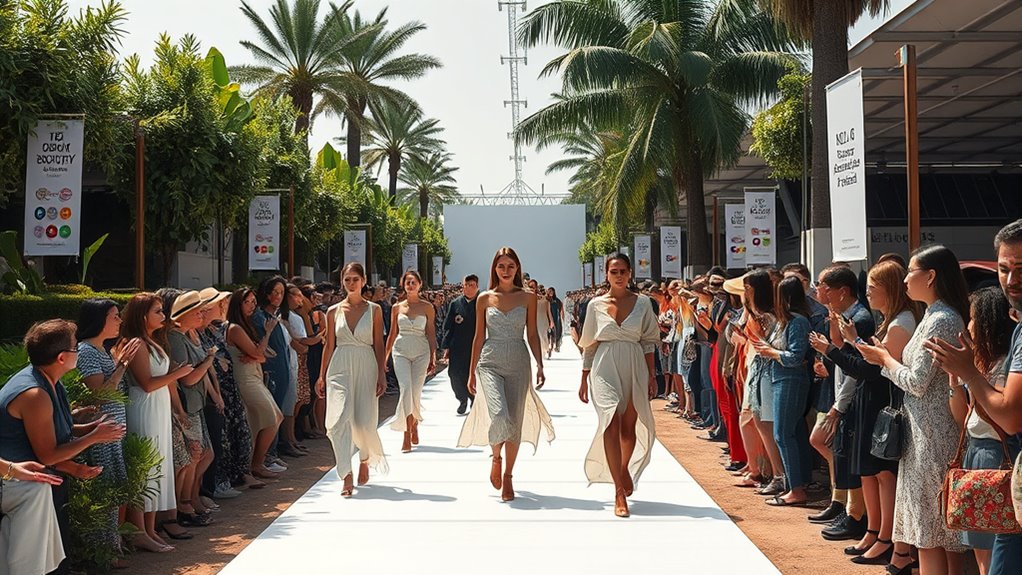
Around the world, fashion weeks are taking bold steps to prioritize sustainability, integrating eco-friendly practices into their core operations. Milan Fashion Week has banned single-use plastics, while Paris Fashion Week requires designers to use eco-friendly fabrics, reducing environmental impact. London Fashion Week emphasizes gender-neutral, inclusive designs, often made from recycled or organic materials to promote sustainability. In Tokyo, avant-garde collections blend traditional craftsmanship with eco-conscious practices, showcasing Japanese designers’ commitment to sustainability. Copenhagen Fashion Week enforces strict standards, including mandatory sustainability reports and circular design principles. Shanghai Fashion Week encourages designers to use biodegradable fabrics and adopt eco-friendly production methods, reducing waste through digital show formats. These initiatives highlight a global shift toward more responsible, eco-friendly fashion industry practices.
Digital Transformation and Virtual Shows on the Global Stage
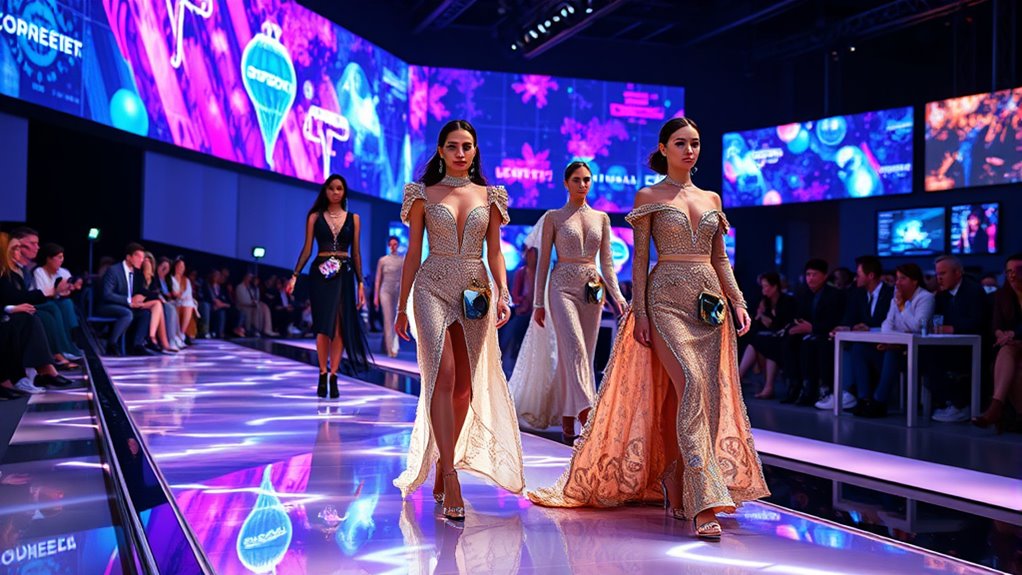
Have you noticed how luxury fashion weeks are transforming through digital innovation? The digital transformation is reshaping how these events reach audiences worldwide, with virtual shows becoming the new norm. Many designers now host online runway presentations, allowing fans and industry insiders to participate remotely. Some key developments include:
- Augmented reality experiences, like those introduced at Paris Fashion Week in 2021, letting viewers virtually try on pieces from home
- A hybrid model combining in-person and digital formats, expanding access and engagement
- Platforms such as Instagram and TikTok amplifying live streams, behind-the-scenes content, and interactive features
These innovations boost online viewership, with some events surpassing millions of digital viewers during live broadcasts. Virtual shows are revolutionizing the global stage for luxury fashion, making it more accessible and immersive than ever before.
Rising Markets and Emerging Fashion Weeks Around the Globe
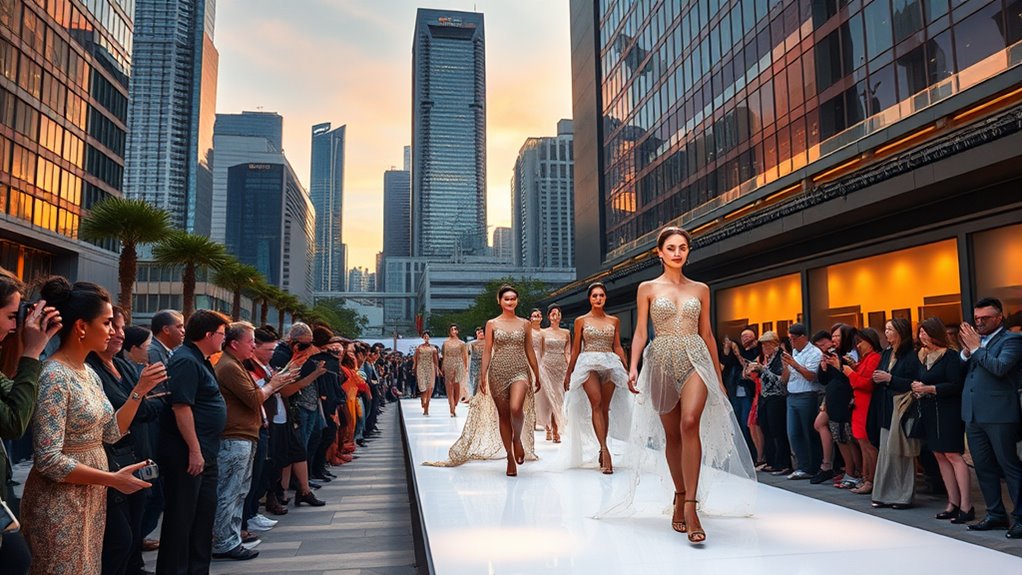
Emerging fashion weeks in markets like Dubai, Lagos, and Jakarta are quickly gaining recognition by showcasing local talent and reflecting regional influences. These events highlight emerging designers who bring fresh perspectives to global fashion, emphasizing cultural heritage and innovative styles. Countries such as India and Brazil are establishing major fashion platforms like Lakmé Fashion Week and São Paulo Fashion Week, positioning themselves as key players in the global fashion scene. These markets attract international buyers and media, boosting their visibility on the world stage. Many of these emerging fashion weeks prioritize sustainability and digital innovation, setting themselves apart in a competitive landscape. Their growth signals a broader trend of diversification, illustrating how new markets are reshaping the global fashion industry with vibrant creativity and regional authenticity.
Unique Attire and Dress Codes in Different Fashion Weeks
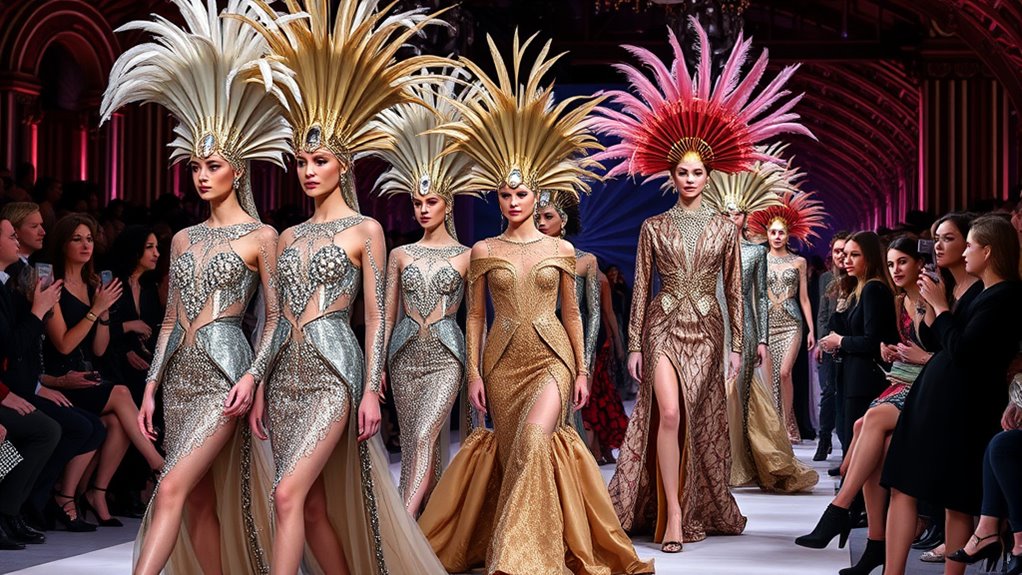
Fashion weeks worldwide showcase more than just designer collections—they also set the tone for attendee attire, reflecting each city’s unique style ethos. Your dress codes and attire choices vary depending on the location:
- In New York, expect polished, commercial looks that emphasize professionalism and trendiness.
- London encourages bold, experimental outfits inspired by street style and individuality.
- Milan highlights high-end Italian craftsmanship with elegant, tailored ensembles showcasing luxury fabrics.
- Paris blends sophistication with avant-garde elements, balancing tradition and innovation in chic, high-fashion looks.
- During events, dress codes shift from ultra-formal, invitation-only attire at couture shows to more relaxed yet stylish outfits at industry parties.
Your wardrobe choices should mirror the event’s theme, designer vibe, and local style norms, ensuring you fit in perfectly.
Industry Impact: How International Events Shape Retail and Trends

International fashion weeks set the standards that influence what consumers want and how retailers plan their collections. When new trends emerge on these stages, they quickly shape buying habits and store displays worldwide. Digital coverage amplifies this effect, making it easier for brands to boost visibility and drive sales across markets.
Trendsetting and Market Influence
Luxury fashion weeks in cities like Paris, Milan, New York, and London serve as powerful platforms that shape global retail and style trends. They are key for trendsetting and exert significant market influence by showcasing innovative designs, craftsmanship, and materials that set the tone for upcoming seasons. As a result, you’ll see these collections directly impact consumer preferences and demand.
You’ll notice:
- The introduction of new aesthetics that quickly become sought-after in both high-end and mass-market sectors.
- Brands adjusting their sales, distribution, and marketing strategies based on event timing and themes.
- Media coverage and celebrity appearances amplifying trends, making them aspirational and widely adopted.
These factors ensure luxury fashion weeks are not just showcases but catalysts that steer the entire fashion industry’s direction.
Retail Strategies and Consumer Choices
Major fashion weeks like those in Paris and Milan directly influence retail strategies and consumer choices worldwide. Retailers often adjust their seasonal collections and marketing plans to align with the styles showcased on runways, ensuring they meet current consumer preferences. These events highlight trending silhouettes, fabrics, and accessories, driving demand across all market segments. Innovative sustainable fabrics and technology-driven designs debuting at fashion weeks inspire retailers to incorporate eco-friendly and high-tech products into their offerings. Media coverage and celebrity appearances during these shows amplify the visibility of new collections, shaping consumer purchasing decisions. As a result, retail strategies become more dynamic, emphasizing the latest trends to satisfy evolving consumer preferences and stay competitive in a fast-changing luxury market.
Planning and Navigating the Global Fashion Calendar
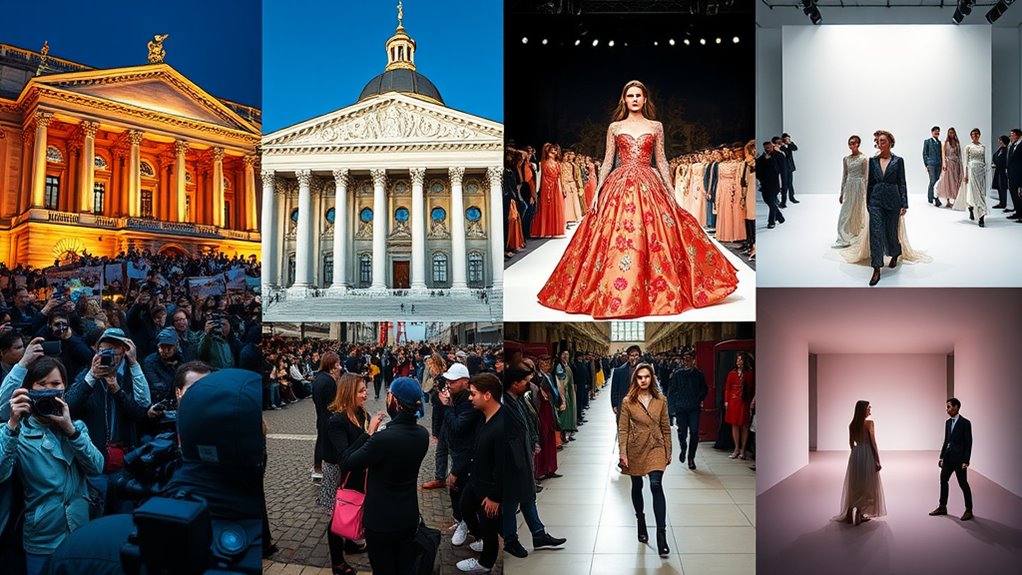
To effectively navigate the global fashion calendar, you need to understand the key dates set by industry organizations and how they coordinate schedules across major cities like New York, Paris, Milan, and London. Fashion weeks occur twice a year in each city, showcasing Spring/Summer collections in September/October and Fall/Winter in February/March. Staying on top involves:
- Knowing the specific dates from organizations like the CFDA, Fédération de la Haute Couture, and Camera Nazionale della Moda
- Tracking specialized events such as haute couture or bridal shows scheduled months in advance
- Keeping up with updates on emerging markets and regional fashion weeks through resources like Fashion Week Online®
Strategic planning around these dates ensures your participation, travel, and media efforts align perfectly with the global fashion calendar.
Frequently Asked Questions
What Are the Top 5 Fashion Weeks in the World?
You’re curious about the top five fashion weeks worldwide. These events are held in New York, Paris, Milan, London, and Tokyo, each renowned for setting industry trends. You’ll find leading designers showcasing their latest collections, attracting top insiders, celebrities, and media attention. These fashion weeks happen twice a year, influencing global style, retail, and marketing strategies. Attending or following them helps you stay ahead in the luxury fashion scene.
What Are the Big 4 Fashion Weeks?
The Big Four Fashion Weeks are the ultimate global fashion showdown, happening twice a year in New York, London, Milan, and Paris. You’ll see the hottest trends that shape the entire industry’s future, each city bringing its own flavor—innovative streetwear, daring creativity, Italian luxury, or haute couture magic. These events command worldwide attention, making them the must-attend, trend-setting spectacles that define what everyone will wear next season.
What Is the Luxury Fashion Capital of the World?
You might already know that Paris is considered the luxury fashion capital of the world. It’s where top designers showcase their most exclusive collections, and its traditions of craftsmanship and innovation set global standards. When you attend Paris Fashion Week, you see the latest in haute couture and luxury trends. The city’s historic influence, prestigious brands, and vibrant fashion scene make it the ultimate destination for luxury fashion enthusiasts like you.
What Are the Fashion Week Dates in 2025?
You’re curious about the 2025 fashion week dates. Typically, major events happen twice a year. For Fall/Winter collections, expect late February to early March, and again in September for Spring/Summer shows. Paris and Milan usually start in late February or early March, while London and New York follow a similar schedule. In September, London and New York host Spring/Summer displays, with Paris and Milan also showcasing their collections.
Conclusion
As you explore luxury fashion weeks around the world, you’ll see how they shape trends and reflect diverse cultures. From sustainability efforts to emerging markets, each event offers a unique glimpse into the future of fashion. But aren’t you curious how these global showcases will continue to evolve and influence your style? Staying informed means you’re always ahead in the fashion game—ready to embrace what’s next on the runway.




